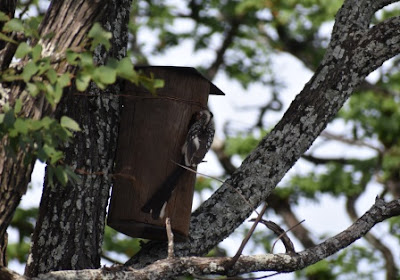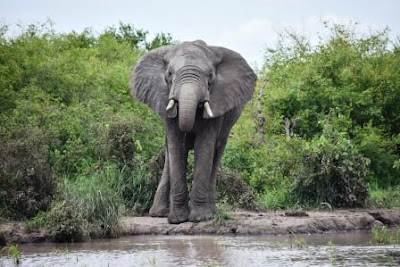A couple of days
ago we finally felt that we had enough spare diesel to be able to do the
January African Waterfowl Census water bird counts at Shumba, Masuma and
Mandavu. We do these counts every January and July and submit the data to
Birdlife Zimbabwe who send it on to Wetlands International, the co-ordinators
of International Waterbird Counts since 1967.
Sue and I have been
involved in various bird data projects over many years and birds are part of
our daily lives at Sinamatella. There are several species and individuals of
birds that have become very tame and treat us as part of the scenery - albeit an unusual part of the scenery that can be relied upon to supply breadcrumbs
and other food, more or less on demand. We have Red-headed weavers nesting on
the veranda above our dining table which van be messy - but interesting. In the
dry season I share my breakfast most mornings with Barbie the Crested Barbet
and her companion who we have inevitably named Ken. Throughout the year the
local group of White-browed sparrow-weavers who nest close to our house in a
big Mopane tree, forage on and around our veranda (especially at meal times)
and recently a pair of Red-billed Hornbills has developed the same habit. They
first started getting tame during the hungry time around end of last dry season
and were here looking for food when the first rain fell - giving Sue an
opportunity for a memorable photograph.......
We have an artificial nest box in the Mopane
tree which has been used in the past by Grey-headed sparrows and by squirrels
but this year the hornbills decided they would use it. Either they breed in
very cramped nest-holes or they have misjudged the size of the box; either way,
we thought they should be offered a
bigger alternative so one day Sue and I made a new, larger box. The hornbills
watched from just a few metres away as I climbed a ladder and fixed the new box
in the tree. I was sure they would be afraid of it but by the time I had
removed the ladder and sat down to watch, they were already investigating and
carrying dummy pieces of nest material which they passed from beak to beak then
dropped on the ground.
Two weeks later
that is what they still do every morning and evening and there is no sign that
they intend to go any further. We'll see what happens.
Meanwhile, back to
the waterfowl census.....
We travelled first
to Shumba where we count at Elephant Pan, Dwarf Goose Pan, Reedbuck Vlei, Big
Shumba, Shumba Pan and Camp Hwange Pan. Rainfall has been below average and
very patchy so far this season but even so we were surprised to find that of
those seven sites, only the two pumped pans, Shumba and Camp Hwange, had any
water. Consequently the count was low and we saw more interesting birds in the
grasslands than we did at the pans. There were a few Grey crowned cranes
stripping seeds from the grass flowers.....
And Carmine and Blue-cheeked bee-eaters in the more open
patches, though the Blue-cheeked were camera shy so Sue only managed to
photograph the Carmine........
As well as birds, the Shumba grasslands usually have something
else interesting to offer. We met up with a Black-backed jackal which trotted
along in front of us for a while but wouldn't stay still for a photo. These two
Steenbok were more accommodating......
But we eventually
left Shumba and headed to Masuma, with a rather disappointing bird count up to
that point. Masuma though, was unusually good. The dam itself had quite a few
water birds such as these two Egyptian geese....
In view of the crocodile that you can see sliding towards
them, the one running away on the left looks the more sensible to me!
Away from the actual dam we had some of the best birding of
the day at a number of small, flooded pans. A Wood sandpiper absolutely refused
to be intimidated by the Land Rover parked right next to it so even I was able
to get a photo......
And my favourite
sighting of the day was this Dwarf bittern.....
At the other end of
the size scale, one of the little pans was occupied by a thirsty elephant......
The difference in amount of water between the Shumba and
Masuma areas was quite startling considering they are only about 14km apart but
it shows the patchiness of this year's rainfall. Mandavu, our next stop, has
had relatively good rain and holds plenty of water as well as plenty of birds.
We counted 437 water birds of 32 species. Mandavu is big and it takes a couple
of hours to scan the whole shoreline (from seven or eight separate points) so
by the end of it we were more than ready to head for home and put the kettle
on. By this stage, anyone reading this blog post probably feels much the same
so I'll leave any write-up of Mandavu's birds for another day!










No comments:
Post a Comment